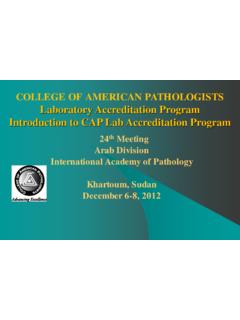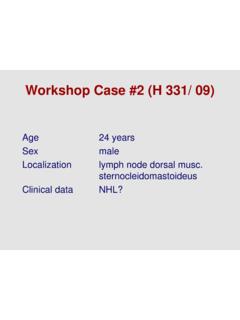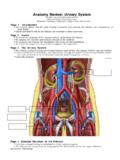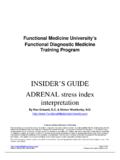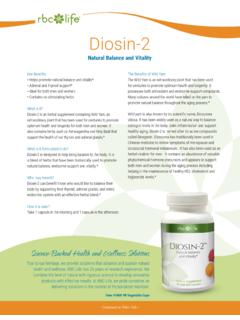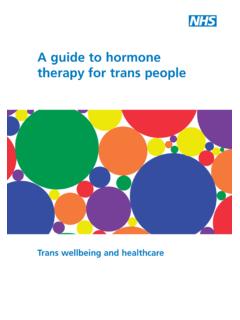Transcription of Gut as an endocrine gland - IAP-AD
1 P R O F : A B D A L H A F I Z H A S S A N K H A T T A B Gut hormones Gut as an endocrine gland The talk will cover the following : Historical background . Why this subject is chosen. Gastro-intestinal hormones and their function. Effects of disturbance in these hormones. Obesity Energy metabolism Hormonal control of food intake Conclusion Introduction Numerous circulating peptide and steroids produced in the body influence appetide through their actions on the hypothalamus ,the brain stem and the autonomic nervous system . These hormones secreted by fat cells ,GIT and the pancreas and adrenal gland .
2 Gut hormones include (CCK) . 2. Peptide PYY . like peptide (Glp-1) (OXM) Peptide(GIP) . All except Ghrelin act to increase staiety and decrease food intake so all act as satiety signals While Ghrelin acts as a hunger hormone by increasing appetide. Cholecytokinin (CCK) Is a gut peptide that has long been established to act as post prandial satiety signal . It is released from the duodenum and jejunum in response to fatty acids . CCK acts at receptors on peripheral vagal afferent which transmit signal to appetite centers within the brain stem. Peptide PYY Secreted from the endocrine L cells of the gut.
3 This peptide has local effect on gut motility or increase food intake in animals . In man it has anoroxigenic effects. PYY level increases in many disease status that show weight loss and vice versa, low in overweight subjects. Glucagon-like peptide (GLP-1) Is a peptide product of preproglucagon gene released from the L cells of the small intestine in response to food ingestion. It is a potent inducer of glucose dependent insulin release, so it is used for treatment of type 2 DM subjects . It also inhibits gastric emptying Oxyntomodulin(OXM) Produced from the preproglucagon gene and released from the small intestine in response to meal.
4 It acts to reduce gastric motility and secretion . Administration of OXM can reduce both food intake and body weight by suppression of Ghrelin . Obestatin Still under investigation. Intraperitoneal and intracerebro- ventericular injection supress food intake and stomach emptying so it antagonises Ghrelin on food intake and body weight . Other GI Peptide (GIP) Produced in the proximal small intestine or CNS where it may play a role in cell control of survival. It also acts as GLP-1 induce glucose dependent insulin release and so can be used in type 2 DM control.
5 It is low in fasting state and rise ten times after meal. Amylin Secreted like insulin by the beta cells of the pancreas in response to food intake . Exogenous amylin Reduce feeding in human and rodents. Slows gasteric emptying and reduce post prandial glucagon secretion . Mechanism of Amylin function Amylin seems to decrease food intake through both central and peripheral mechanism It s receptors are in the hypothalamus nuclei and the mean basal concentration is higher in obese than in lean human subjects . So Amylin administration may have potential for inducing weight loss in obese subjects.
6 Ghrelin The endogenous agonist of the growth hormone ,is the only circulating factor known to increase appetite. Increased by weight loss ,fasting and insulin induced hypoglycemia . So periphral adminsteration of Ghrelin stimulate food intake and decrease fat utilization . Summary Of Gut hormone Function Local effects in GI motility and secretions. Altering the rate at which nutrients are delivered to compartments of almentary contr ol. Control food intake. Thus gut hormone have come to accupy a central place in the complex neuro- endocrine interaction that underlie the regulation of energy balance.
7 Gut hormone function to optimize the process of digestion and absorption of nutrient by the gut. So gut hormones influence energy hoemeostasis. Gut hormones in obesity and in regulation of appetite and energy hoemostasis Introduction to the problem of obesity Obesity is a major health problem in the developed and developing world with a dramatic influence on morbidity and mortality in addition to major economic consequences. Obesity is the main cause of death at young age group . Gut hormones and appetide and metabolism The world wide obesity epidmic lead to better understanding of the mechanisms of energy homeostasis.
8 Neural and endocrine signals from gut to brain are thought to play a vital role in regulation of appetide. Mechnism of obesity Energy balance is a metabolic state that exists when total body expendure equals dietary energy intake . Inbalance in energy results in weight gain and then obesity. Energy control is dertermind not only by hypothalamus but also by the pancreas ,adrenal and GI peptides. Gasterointestinal Signalling Peptide In Obesity The GIT signals are released from specific endocrine cells that are localized through GIT . These are relayed to the appetide centers of the brain mainly in hypothalamus and hind brain via neural and endocrine pathway thus impacting on satiety and energy intake.
9 Many of these GI peptide are also expressed as neuropeptide therefore the brain is involved in energy balance and in food intake. The hypothalamic appetide circuits The hypothalamus and the dorsal vagal complex appear to be important CNS regions directly regulating appetide . Recently some of the main neural circuits involved have been identified . The arcuate nucleus of the hypothalamus . There are two well characterized neuronal populations involved in appetide inhibiting and appetide stimulating neuropeptide Y(NPY) Thus mutations disrupting these hypothalamic systems cause OBESEITY in human.
10 That act both peripheral (gut) and central (CNS) targets. long term control of energy balance is brought about by adipose tissue by producing hormones eg. Leptin ,an adiponectin resisten TNF2 which influence food intake . Other hormones involved in obesity Conclusion 1 There is evidence that the gut acts as a nutrient and energy balance sensor resulting in release of several hormones . These signals inform the CNS about long and short term energy availability . Contributing to the control of feeding behavior and over all energy balance . Conclusion 2 Gut hormones may be an effective target for the treatment of obesity.
